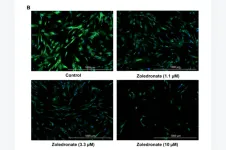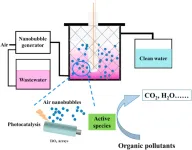(Press-News.org)
“In the present study, we used multiple complementary approaches to evaluate the possible effects of zoledronic acid on cellular senescence.”
BUFFALO, NY- May 15, 2023 – A new research paper was published on the cover of Aging (listed by MEDLINE/PubMed as "Aging (Albany NY)" and "Aging-US" by Web of Science) Volume 15, Issue 9, entitled, “In vitro and in vivo effects of zoledronic acid on senescence and senescence-associated secretory phenotype markers.”
Zoledronic acid has been found to reduce fracture risk and, in some studies, to decrease mortality in humans and extend lifespan and healthspan in animals. Because senescent cells accumulate with aging and contribute to multiple comorbidities, the non-skeletal actions of zoledronic acid could be due to senolytic (killing of senescent cells) or senomorphic (inhibition of the secretion of the senescence-associated secretory phenotype (SASP)) actions.
In this new study, researchers Parinya Samakkarnthai, Dominik Saul, Lei Zhang, Zaira Aversa, Madison L. Doolittle, Jad G. Sfeir, Japneet Kaur, Elizabeth J. Atkinson, James R. Edwards, Graham G. Russell, Robert J. Pignolo, James L. Kirkland, Tamar Tchkonia, Laura J. Niedernhofer, David G. Monroe, Nathan K. Lebrasseur, Joshua N. Farr, Paul D. Robbins, and Sundeep Khosla from the Mayo Clinic, Phramongkutklao Hospital and College of Medicine, Eberhard Karls University, University of Minnesota, University of Oxford, and University of Sheffield tested the above hypothesis using multiple complementary approaches (in vitro, in vivo, and in silico) to evaluate possible effects of zoledronic acid on modulating cellular senescence.
The researchers first performed in vitro senescence assays using human lung fibroblasts and DNA repair-deficient mouse embryonic fibroblasts, which demonstrated that zoledronic acid killed senescent cells with minimal effects on non-senescent cells. Next, in aged mice treated with zoledronic acid or vehicle for 8 weeks, zoledronic acid significantly reduced circulating SASP factors, including CCL7, IL-1β, TNFRSF1A, and TGFβ1 and improved grip strength. Analysis of publicly available RNAseq data from CD115+ (CSF1R/c-fms+) pre-osteoclastic cells isolated from mice treated with zoledronic acid demonstrated a significant downregulation of senescence/SASP genes (SenMayo).
To establish that these cells are potential senolytic/senomorphic targets of zoledronic acid, the team used single cell proteomic analysis (cytometry by time of flight [CyTOF]) and demonstrated that zoledronic acid significantly reduced the number of pre-osteoclastic (CD115+/CD3e-/Ly6G-/CD45R-) cells and decreased protein levels of p16, p21, and SASP markers in these cells without affecting other immune cell populations.
“Collectively, our findings demonstrate that zoledronic acid has senolytic effects in vitro and modulates senescence/SASP biomarkers in vivo. These data point to the need for additional studies testing zoledronic acid and/or other bisphosphonate derivatives for senotherapeutic efficacy.”
Read the full study: DOI: https://doi.org/10.18632/aging.204701
Corresponding Author: Sundeep Khosla - khosla.sundeep@mayo.edu
Keywords: senescence, senolytics, aging, bone, bisphosphonates
Sign up for free Altmetric alerts about this article: https://aging.altmetric.com/details/email_updates?id=10.18632%2Faging.204701
About Aging-US:
Launched in 2009, Aging (Aging-US) publishes papers of general interest and biological significance in all fields of aging research and age-related diseases, including cancer—and now, with a special focus on COVID-19 vulnerability as an age-dependent syndrome. Topics in Aging go beyond traditional gerontology, including, but not limited to, cellular and molecular biology, human age-related diseases, pathology in model organisms, signal transduction pathways (e.g., p53, sirtuins, and PI-3K/AKT/mTOR, among others), and approaches to modulating these signaling pathways.
Please visit our website at www.Aging-US.com and connect with us:
SoundCloud
Facebook
Twitter
Instagram
YouTube
LabTube
LinkedIn
Reddit
Pinterest
Click here to subscribe to Aging publication updates.
For media inquiries, please contact media@impactjournals.com.
Aging (Aging-US) Journal Office
6666 E. Quaker Str., Suite 1B
Orchard Park, NY 14127
Phone: 1-800-922-0957, option 1
###
END
URBANA, Ill. — From self-driving tractors to weeding robots and AI-powered data collection, automated machinery is revolutionizing agricultural production. While these technological advancements can greatly improve productivity, they also raise new questions about safety measures and regulations. To address these issues, a recent study from the University of Illinois reviewed current academic literature on the safety of automated agricultural machines. Based on a review of more than 60 papers, the researchers identified three ...
1. Experts say it’s not yet time to take off masks in the health care setting
Abstract: https://www.acpjournals.org/doi/10.7326/M23-1190
URL goes live when the embargo lifts
A new commentary from infectious disease experts at George Washington University School of Medicine and the National Institutes of Health (NIH) says for patient safety, masking should continue in health care settings. This message conflicts with a recent commentary from authors from 8 U.S. institutions suggesting that the time for universal masking is over. The commentary is published in Annals of Internal Medicine.
Masking has been a controversial ...
New University of Colorado Boulder research shows the number of farms globally will shrink in half as the size of the average existing farms doubles by the end of the 21st century, posing significant risks to the world’s food systems.
Published today in the journal Nature Sustainability, the study is the first to track the number and size of farms year-over-year, from the 1960s and projecting through 2100.
The study shows that even rural, farm-dependent communities in Africa and Asia will experience a drop in the number of operating farms.
“We see a turning point from widespread farm creation to widespread consolidation on a global level, and that's ...
Drugs approved in the US require “substantial evidence” that they are effective. But an investigation by The BMJ into the recent approval of the antibiotic Recarbrio from Merck suggests that these standards are being bypassed.
Peter Doshi, senior editor at The BMJ, describes how US Food and Drug Administration (FDA) scientists had serious doubts about Recarbrio - a product 40 times more expensive than an existing generic alternative - but the agency approved it anyway.
Did the FDA break its own rules in approving this antibiotic, and what does this case tell us about problems within the agency, he asks?
Recarbrio is a combination therapy made up ...
Two years of heavy exposure to TCE, a liquid chemical that lingers in the air, water and soil, may increase the risk of Parkinson’s disease by 70%.
Previous research has linked TCE, or trichloroethylene, to certain cancers, but a new study publishing in JAMA Neurology on May 15, 2023, is believed to be the first large-scale study to demonstrate its association with Parkinson’s.
TCE has been used for industrial and commercial purposes for nearly 100 years, and was used ...
Researchers from The University of Technology Sydney (UTS) have measured the extent to which a bone fracture can lead to early death, and created a publicly available tool that doctors and patients can use to calculate risk.
The research, ‘Skeletal Age’ for mapping the impact of fracture on mortality has just been published in the prestigious scientific journal, eLife.
In the study of more than 1.6 million adults, the scientists found that a bone fracture was associated with a loss of one to ...
Indiana University School of Medicine researchers studying clonal hematopoiesis of indeterminate potential (CHIP), a blood condition that may increase the risk of blood cancer, discovered that obesity was strongly associated with the condition. Their findings were recently published in the Journal of Clinical Investigation.
CHIP is a condition where blood cells accumulate genetic mutations, increasing the risk of developing blood cancer. Although CHIP is common in aging, the risk factors that contribute to the condition are poorly understood.
“Our study’s results showed being overweight ...
The study is led by Xiaojun Han (School of Chemistry and Chemical Engineering, Harbin Institute of Technology).
With the rapid development of urbanization and industrialization, environmental problems became increasingly serious. Dye wastewater is considered to be one of the biggest challenges due to its high toxicity. Organic dyes have mutagenic, teratogenic, and carcinogenic properties, and threaten the health and life of humans while hindering plant photosynthesis, which brings risks to the ecosystem. Traditional organic pollutant treatment ...
As more people use cannabis for recreational purposes, attitudes towards the drug have changed. For example, research has shown that dispensaries often recommend cannabis – also referred to as marijuana – to pregnant women to ease pregnancy symptoms, especially morning sickness.
There is a growing body of literature attesting to poor child outcomes if cannabinoids are consumed during pregnancy. The exact effects on the developing fetus, however, remain unclear. Researchers in the US have now examined how timing of cannabis exposure during pregnancy impacts fetal development.
“We show that even when marijuana use occurred only ...
EMBARGOED UNTIL SUNDAY 14 MAY 2023 AT 00:01 CET
Severe hot flashes after menopause increase metabolic syndrome risk in women
Women who experience more severe hot flashes after menopause are more likely to develop metabolic syndrome and high blood pressure, according to research presented at the 25th European Congress of Endocrinology in Istanbul. The findings of this long-term study highlight the importance of using hormone replacement therapy for menopause in these women.
Metabolic syndrome is a group of three or more ...


